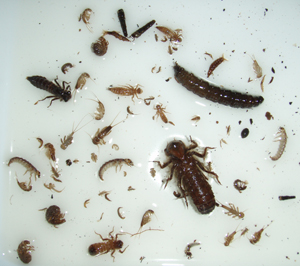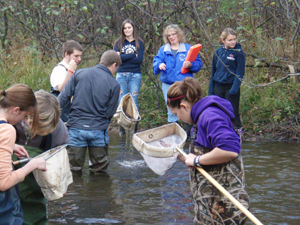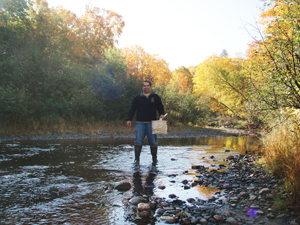Aquatic Macroinvertebrate Sampling
 What is a macroinvertebrate?
What is a macroinvertebrate?
An invertebrate is any organism lacking backbone such as crustaceans (i.e. crabs), insects (i.e. grasshopper), and mollusks (i.e. clams), annelids (i.e. worms), and arachnids (i.e. spiders). Amacroinvertebrate is one that you can see with the naked eye.
Why study aquatic macroinvertebrate communities?
There are many reasons to study aquatic macroinvertebrates, but one of the main reasons is that they are important components of aquatic ecosystems. The main role they play is as a food source for larger organism such as fish and amphibians, but they may also play a role in the breakdown and recycling of organic matter in the system. In addition, they are excellent indicators of the health of a water system. Some macroinvertebrates are very sensitive to slight changes in water conditions from pollution, habitat modification or severe natural events.
 Macroinvertebrate sampling provides a relatively easy way to assess the water quality of a stream. The types and numbers of macroinvertebrates (mostly insect larvae/nymphs) that form the biological community at a particular stream location are shaped by both the nature of the stream and the quality of water that drains into the stream. A strategically placed collection of macroinvertebrate samples can provide a method for evaluating water quality of the entire watershed and for pin-pointing specific problem areas within it.
Macroinvertebrate sampling provides a relatively easy way to assess the water quality of a stream. The types and numbers of macroinvertebrates (mostly insect larvae/nymphs) that form the biological community at a particular stream location are shaped by both the nature of the stream and the quality of water that drains into the stream. A strategically placed collection of macroinvertebrate samples can provide a method for evaluating water quality of the entire watershed and for pin-pointing specific problem areas within it.
The KBIC Natural Resources Department has been conducting macroinvertebrate surveys since 2000. The sites have changed over the years but sampling has occurred in the fall of each year. These same stream and river systems are sampled under the tribal water program. We have also gone out with both the L’Anse and Baraga area schools for sampling as a means to educate the area youth on what macroinvertebrates are and their importance within a given system.
 Additional Resources
Additional Resources
Michigan Technological University – Macroinvertebrates as Bioindicators of Stream Health:http://wupcenter.mtu.edu/education/stream/Macroinvertebrate.pdf
EPA Water Monitoring & Assessment - Chapter 4: Macroinvertebrates and Sampling: http://water.epa.gov/type/rsl/monitoring/vms40.cfm
Western Australia Water & Rivers Commission: http://nynrm.sa.gov.au/portals/7/pdf/landandsoil/17.pdf
